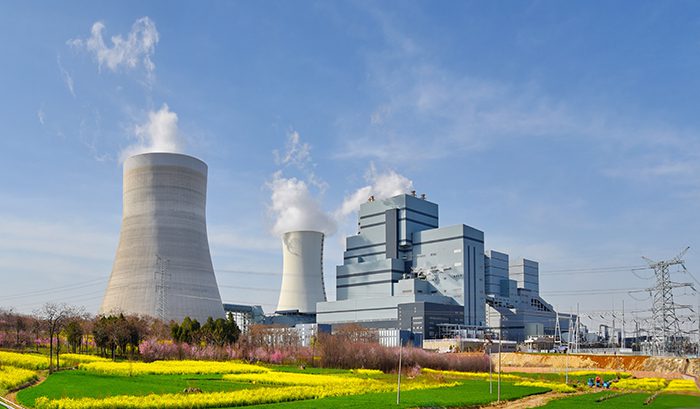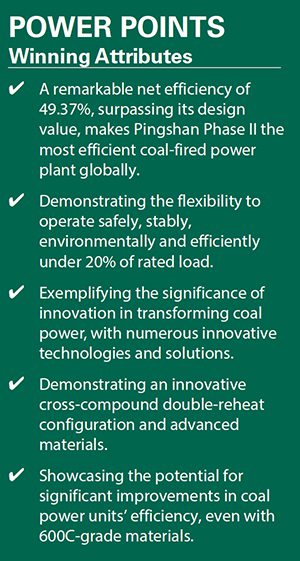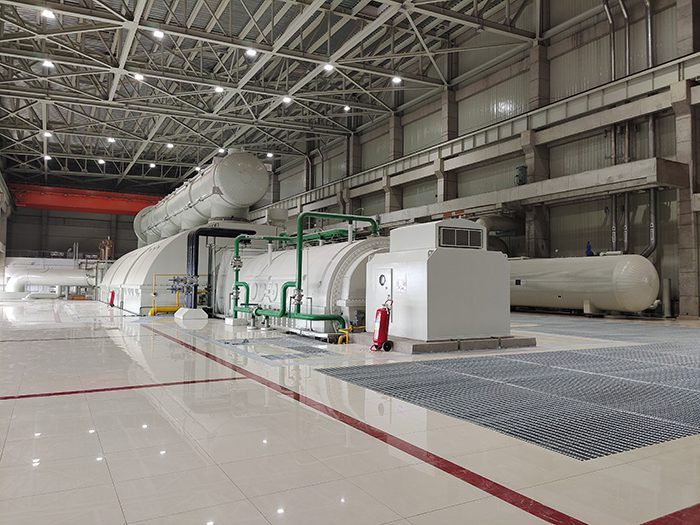China’s Pingshan Phase II Sets New Bar as World’s Most Efficient Coal Power Plant

Pingshan Phase II, a cutting-edge 1.35-GW ultrasupercritical coal-fired unit, achieves a remarkable net efficiency of 49.37%—making it the world’s most efficient coal-fired power plant. The state-of-the-art plant, which commenced operations in April 2022, utilizes mature 600C materials and equipment, showcasing the transformative potential of innovation in the realm of coal power.
If there is a crowning moment in the long haul to implement a potentially groundbreaking technology, it’s when an independent assessment confirms its effectiveness. At Pingshan Phase II, that moment came on Dec. 13, 2022—eight months after it was put into commercial operation—when a Siemens and Steinmueller–led unit performance acceptance test confirmed the 1,350-MW ultrasupercritical (USC) coal-fired unit’s lower heating value (LHV) net efficiency reached 49.37%, better even than its design value.
Developed and built by Shenergy Co., the extension of the Pingshan Power Plant, located in the Huaibei Economic Development Zone of China’s Anhui Province, is a single unit built in a high-low biaxial arrangement with double reheat. Brought online in April 2022, the project operated and managed by Shenergy subsidiary Huaibei Shenergy Power Generation Co. is the largest single unit of Shenergy’s 8.3-GW coal-fired fleet.
According to Shenergy, it is also the Shanghai government-owned entity’s most innovative unit. That’s especially remarkable given that Shenergy has in recent years built several exemplary coal power projects. In 2015, POWER recognized Waigaoqiao No. 3 (also known as “Waisan”), a twin 1,000-MW primary reheat USC unit plant in Shanghai with a steam temperature of 600C that was brought online in 2008. And, in 2020, the magazine highlighted Shenergy Power Technology’s efforts to boost the efficiency of a 320-MW subcritical coal unit, Xuzhou Unit 3, to beyond 43.56%—higher than all existing Chinese supercritical units, and even many USC units.

A Remarkable Legacy of Innovation
Pingshan Phase II evolved from efforts led by technology pioneer Professor Feng Weizhong to modernize coal technology, focusing on energy savings, efficiency assurances, safety, and environmental improvements. At the time, Feng, who is now general manager of Shenergy Power Technology, received significant recognition—including ASME’s 2016 Prime Mover Award—for leading the development of the pioneering single-reheat Waigaoqiao No. 3 project.
But as Waigaoqiao No. 3’s general manager, he also implemented several innovative technologies between 2009 and 2011 to continuously boost the plant’s performance, gradually improving its average annual net operating efficiency to 44.5%. Those efforts resulted in pollutant emissions that today “meet and exceed gas turbine emission standards,” Li Li, a Shenergy Power Technology engineer, told POWER.
However, nearly a decade before—as construction of Waigaoqiao No. 3 was kicking off in 2005—Feng had also completed research on a different technology that sought to address challenges with the conventional double-reheat system at USC units. Double reheat technologies employ a first steam reheat loop and second reheat loop, presenting efficiency gains compared to single reheat units. “Although the use of secondary reheating technology is a mature technology, the system is complex, requiring high investment,” Li said.
Arranging large-diameter wall pipes within the plant building is also “quite difficult,” he noted. “Moreover, the resistance and heat dissipation loss of the pipe also devour a considerable part of the incremental income of secondary reheating. If the traditional design is carried out, compared with the primary reheat, the net efficiency gain obtained is difficult to compensate for the increase in input. That’s why secondary reheat technology has not continued to be applied and developed after their early application in Europe, the U.S., and Japan,” he explained.
Feng’s innovation, patented in 2011, set out to overhaul the system with an elevated and conventional layout. The design, known as an “Elevated T-G unit,” essentially splits the turbines into two trains. The front train comprises a high-pressure turbine and intermediate-pressure turbine coaxial with one generator as the front unit. It is mounted on top of a two-pass boiler or near the outlets of the tower-type boiler steam headers, which is about 82 meters (m) above ground level. The rear train comprises two intermediate-pressure turbines and three low-pressure turbines coaxial with another generator. The rear unit retains its conventional position, which is roughly 17 m above ground level (Figure 1).

“The turbine generator set technology with high and low spindle arrangement can greatly shorten the high-temperature and high-pressure steam pipeline between the boiler and the steam turbine, saving a large number of pipelines and corresponding investment,” Li explained. “It also reduces the pressure loss and heat dissipation loss of the pipeline, thereby improving the economy of the unit.”
At the same time, the configuration makes up for several potential drawbacks, such as system complexity and their ensuing cost increases. But as significantly, it tackles pipeline layout difficulties, large-resistance and heat dissipation loss, and poor adjustment inertia owing to the system’s substantial steam storage capacity. “Therefore, this technology breaks the bottleneck of the development of high-parameter and secondary reheating units and releases the development space of high-parameter and secondary reheating,” Li said.
Along with the novel layout design, the concept notably incorporates a series of other efficiency improvements and energy-saving techniques to the thermal system, turbine, boiler, pumps, and fans. All of these attributes were integrated into Pingshan Phase II to further improve unit efficiency as well as its flexibility, Li added.
A National Demonstration Project
In 2009, Shenergy launched engineering, research into the technology, yielding a 1.35-GW plant design with a projected net efficiency of 48.92%. As commissioned by China’s National Energy Administration, the China Electric Power Planning and Design Institute vetted and affirmed the technology. The government later prioritized Pingshan Phase II as a national demonstration project, propelling its innovative significance. In March 2015, however, owing in part to Shanghai’s carbon emission index control requirements at that time, Shenergy made the decision to build the plant in Huaibei—not at Waigaoqiao as had been originally envisioned.
Feng spearheaded construction of the novel plant, first as director and general manager of the project preparation office, and then as chairman of the board. Completion of the project, from construction start (in July 2018) to the unit’s full-load continuous operation test (in June 2021) took three years, Li said.
Pingshan Phase II’s flexibility has also been rigorously tested. In May 2021, the project conducted a “deep power reduction test,” which demonstrated the unit could feasibly operate at under 20% of its rated load as necessary. The test required “overcoming more than seven challenging aspects related to deep power reduction,” Shenergy noted. Its success “set a benchmark of both high efficiency and high flexibility.”
The project was ultimately declared commercially operational in April 2022, and it marked its final milestone, the unit performance acceptance test, in December 2022. “The overall project cycle was [smooth], on time and within the budget,” Li noted. Fine-tuning the design and relying on China’s strong construction capacity were pivotal in achieving this, he underscored.
Overcoming Major Technical Challenges
While Pingshan Phase II’s innovative cross-compound double reheat configuration (Figure 2) is noteworthy—and deserving of POWER‘s Top Plant focus—the project features a long list of cutting-edge attributes, including generalized regeneration series technology, elastic regeneration technology, full-load low-oxygen, and low-nitrogen combustion technology. Still, like many first-of-a-kind projects, the project encountered “many major technical challenges,” but these were resolved, Li added.

A prominent issue was related to overspeed and stability issues. “The shafting inertia is significantly smaller than that of the conventional turbine generator set of the same capacity grade,” Li explained. That could have led to “severe overspeed of the high-level turbine generator set in the event of load shedding and dynamic instability in the event of a three-phase short-circuit fault in the transmission line near the power plant side.”
To solve the problem, Feng innovated “an access system scheme,” combining a three-coil step-up transformer for high and low turbine generators with different outlet voltages. The solution entailed “using the electromagnetic binding effect between high and low generators,” Li said.
Shenergy also proactively resolved a problem related “to the direct connection of extremely short pipelines,” he noted. “After adopting the high and low arrangement, the high-temperature and high-pressure steam pipeline connecting the boiler and the steam turbine can be greatly shortened. But, if the conventional pipeline design technology is still retained, the rigidity of the pipeline system can only be reduced by setting more elbows to create a detour, so that the thermal stress generated by the pipeline system (when the steam temperature rises to the rated temperature during operation) can be accepted by the equipment.”
However, that would have proven costly in both investment and efficiency. After “deep research,” Feng invented a system that directly connected the turbine with the boiler via high-temperature and high-pressure pipelines. “The thermal expansion and thermal stress of the pipeline are absorbed by the flexible deformation of the small-diameter pipe bundle connected to the boiler outlet header, which breaks through the major difficulty of how to absorb the thermal stress of large-diameter short pipeline,” Li said.
A Significant Role for Future Coal Power Development
For Shenergy, the most significant takeaway from developing and building the pioneering project is that coal power units can “still be greatly improved on the basis of 600C-grade materials.” That’s an important consideration given cost and environmental pressures—especially because 700C-grade material technology is not mature, Li noted. “In fact, at present, the efficiency of the Pingshan Phase II engineering unit has exceeded the expected efficiency of the ultrasupercritical power generation technology of the 700C level.”
However, even more innovation is on the horizon, Li suggested. Feng has “initiated and completed the research of a new generation of 660-MW grade steam turbine body at full-height layout, based on the existing 600C grade materials,” he noted. “Using this technology, the net efficiency of the unit can exceed 50%.” Design and engineering research for that technology has wrapped up, and Shenergy Power Technology is now awaiting the green light for project implementation.
Still, Pingshan Phase II is already playing an outsized role in China’s development of low-carbon coal-fired power technology. China’s National Energy Administration requires that national demonstration projects must be operated for two years before clearance for wider acceptance. For now, Shenergy is “preparing for the summary and acceptance of the Pingshan Phase II project, and then it will be promoted and applied,” Li said.
—Sonal Patel is a POWER senior associate editor (@sonalcpatel, @POWERmagazine).